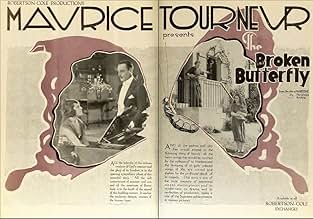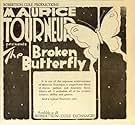Adicionar um enredo no seu idiomaBefore she parts from him for a while, a woman falls in love with a composer, working on a symphony, who she encounters in the forests of Canada.Before she parts from him for a while, a woman falls in love with a composer, working on a symphony, who she encounters in the forests of Canada.Before she parts from him for a while, a woman falls in love with a composer, working on a symphony, who she encounters in the forests of Canada.
- Direção
- Roteiristas
- Artistas
Avaliações em destaque
Pauline Stark has been reared by her aunt, who hates her. Her only friend is her dog. Composer Lew Cody, vacationing in Canada, comes across her, and they fall in love. Her offers her marriage, but she has no name and refuses, so he returns to New York to compose and debut his new symphony named for her, and she gives birth to his daughter. The symphony, however, is a flop, and her aunt, to complete Pauline's shame at an illegitimate daughter, tells her that she stole Pauline from her noble father when he abandoned her. Then she kicks Pauline and the baby out into the perpetually stormy Canadian night.
Nice woman. The movie has its problems. Lew Cody is a stiff, who can't raise much in the way of looking as miserable as his character is supposed to be, although he looks a bit glum. That doesn't matter, because this movie is directed by Maurice Tourneur, that most painterly of directors. Every frame in the first half looks like a Pre-Raphaelite portrait, with Tourneur using every trick in the book (long chapters of which he wrote) to vary composition: not only set design and props, but actually changing the shape of the frame; for a time the frame is shaped like a Gothic arch.
It's astonishingly lovely, and the amber tint on the copy I saw makes me wish Tourneur had had opportunity to work in Technicolor, perhaps with that most painterly of cinematographers, Jack Cardiff. What a team they would have made! Alas, it was never to be; after the Second World War, Tourneur made only two movies. Although he lived to be 85, dying in 1961, an automobile accident in 1949 ended his film career.
Nice woman. The movie has its problems. Lew Cody is a stiff, who can't raise much in the way of looking as miserable as his character is supposed to be, although he looks a bit glum. That doesn't matter, because this movie is directed by Maurice Tourneur, that most painterly of directors. Every frame in the first half looks like a Pre-Raphaelite portrait, with Tourneur using every trick in the book (long chapters of which he wrote) to vary composition: not only set design and props, but actually changing the shape of the frame; for a time the frame is shaped like a Gothic arch.
It's astonishingly lovely, and the amber tint on the copy I saw makes me wish Tourneur had had opportunity to work in Technicolor, perhaps with that most painterly of cinematographers, Jack Cardiff. What a team they would have made! Alas, it was never to be; after the Second World War, Tourneur made only two movies. Although he lived to be 85, dying in 1961, an automobile accident in 1949 ended his film career.
In the wiles of Canada outcast Maracene Eliot has but one friend, her dog. The aunt who raised her has done so cruelly leaving the young lady isolated and without a past. She meets a composer who falls for her but she refuses to marry him because she has no history. He returns to Europe, writes a classical piece inspired by her and it promptly flops. Meanwhile Marcene decides to drown herself and the child of the composer. Professionally and personally at a low point he glumly goes about his life when he meets Marcene's sister who explained her sisters predicament and perhaps the reason for the aunt's callousness. He marries the sister and then returns with her to Canada where answers to nagging questions await along with a couple of other surprises.
This copious tear jerker has more than its fair share of poignant moments in a somewhat contrived narrative that remains mostly in a permanent state of melancholy. Director Maurice Tourneur vision however is both graceful and deliberate in his telling, presenting a good deal of tasteful canvases that covers for the lack of action. Pauline Stark's touching performance is ultimately what carries the picture and opens the floodgates as a true orphan of the storm.
This copious tear jerker has more than its fair share of poignant moments in a somewhat contrived narrative that remains mostly in a permanent state of melancholy. Director Maurice Tourneur vision however is both graceful and deliberate in his telling, presenting a good deal of tasteful canvases that covers for the lack of action. Pauline Stark's touching performance is ultimately what carries the picture and opens the floodgates as a true orphan of the storm.
Você sabia?
- Erros de gravaçãoAs Daniel stands up from the bed with his daughter in his arms, her head is turned to her right, but after the cut it's to her left.
Principais escolhas
Faça login para avaliar e ver a lista de recomendações personalizadas
Detalhes
- Data de lançamento
- País de origem
- Idiomas
- Também conhecido como
- Le papillon meurtri
- Locações de filme
- Empresas de produção
- Consulte mais créditos da empresa na IMDbPro
- Tempo de duração58 minutos
- Mixagem de som
- Proporção
- 1.33 : 1
Contribua para esta página
Sugerir uma alteração ou adicionar conteúdo ausente

Principal brecha
By what name was The Broken Butterfly (1919) officially released in Canada in English?
Responda



















